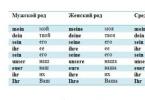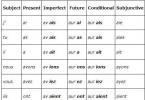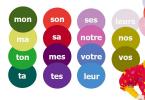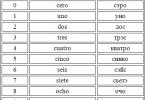Demonstrative adjectives in French ( adjectifs demonstratifs) easy to remember because there are only four words.
What do demonstrative adjectives look like?
Demonstrative adjectives in French are placed before and indicate the gender or number of a noun. And they look like this: Ce, Cet, Cette, Ces.
- Ce– this: defines a masculine noun in the singular;
- Set– this one: indicates a masculine noun in the singular if it begins with a vowel or with a dumb “h”;
- Cette– eta: defines a feminine noun in the singular;
- Ces– these: indicates a masculine or feminine plural noun.
Note that the masculine demonstrative adjective Set used before a noun that begins with a vowel or a silent "h". Before a noun that begins with a consonant or with h aspirated, the form is used Ce.
To make it clearer and clearer for you, let's see how we use demonstrative adjectives with nouns:
- Ce livre - this book (masculine, before a consonant);
- Ce héro - this hero (masculine before the aspirated "h");
- Cet ouvrier - this worker (masculine before a vowel);
- Cet homme - this person (masculine before dumb "h");
- Cette femme - this woman (feminine before a consonant);
- Cette histoire - this story (feminine before silent "h");
- Cette école - this school (feminine before a vowel);
- Ces livres - these books (plural before a vowel);
- Ces héros - these heroes (plural before aspirated "h");
- Ces femmes - these women (plural before a consonant);
- Ces histoires - these stories (plural before silent "h").
Notice the use of demonstrative adjectives in the short text example:
J'aime beaucoup cet etudiant. C'est lui qui a écrit ces articles et a fait tous ces exercices. C'est lui qui a aidé tous ces collègues. Ce travail est fait aussi par lui. Cette revue est corrigée par mon bon etudiant. Son activite est remarquable. - IVeryI lovethisstudent. It was he who wrote these articles and did all these exercises. He helped all his colleagues. This work was also done by him. This journal has been corrected by my good student. His work is wonderful.
Demonstrative adjectivesLocation of demonstrative adjectives
Adjectifs demonstratifs are located next to nouns. Demonstrative adjectives are always placed before the nouns they qualify or before the adjectives that precede the noun. For example:
- Ce bon élève - this good student
In addition, demonstrative adjectives can be reinforced with particles ci And la, which are placed after the noun through a hyphen. Note:
- Cet arbre-ci is a tree
- Cette semaine-ci - this week
Particles ci And la as if accentuating, emphasizing the meaning of the word, which is why it acquires an enhanced connotation: it is this tree, this particular week.
It is important not to confuse
Try not to confuse demonstrative adjectives with “C’est is”.
The expression "C'est" consists of two words: the demonstrative pronoun ce (this) + the linking verb être (est) - "to eat". In this situation, the demonstrative pronoun ce (this) is shortened to "c'" because it occurs with a vowel; and the verb être in this case is not translated into Russian.
All together, "C'est" is translated into Russian as "This". It is followed by an indication of the person or thing being referred to. The noun that denotes this subject is used with the indefinite article. This turnover also has the plural form Ce sont, which is used before referring to several persons or objects. In such a turnover, the verb "est" is already a predicate. And, as a result, we get:
- C'est une table - This is a table;
- C'est Michel, mon ami - This is Michel, my friend;
- Ce sont mes amis - These are my friends.
Compare: C'est une table. Cette table est ronde. - It is a table. This table is round.
Russian word "This" can be translated into French in two ways: using demonstrative adjectives and with turnover "C'est". The main thing is not to confuse.
It is also important not to confuse demonstrative adjectives and demonstrative pronouns (Ce, Celui, Celle, Ceux, Celles, etc.). The difference in their usage is that demonstrative pronouns replace nouns and are used without them. Whereas demonstrative adjectives always come before the noun they define, this means that the noun is not removed from the sentence.
Memory exercise
Do a little exercise. In the following nouns, replace the article with the appropriate forms of the demonstrative adjective Ce, Cet, Cette, Ces:
Le livre, la table, l'étudiant, le mur, la chaise, les cahiers, les héros, l'histoire, la revue, le journal, la chanson, le stylo, l'encrier, le professeur, la serviette, les enfants , les exercices, la maison, la joie.
Now, replace the dots with a suitable demonstrative adjective in the following sentences:
1…table est ronde. 2…livres sont interestants. 3…ville est grande. 4…étudiants sont ici. 5…journal me plaît beaucoup. 6…salle d'études est claire. 7…chapeau est blanc. 8… murs sont gris. 9…serviette est sur la table. 10…etudiant est très sérieux.
Here they are, funny and interesting, demonstrative adjectives in French!
Adj. dem. f. Sing. V. ce. ⇒CE2, CET, CETTE, CES, adj. dem. )




